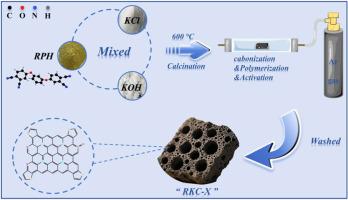Phthalonitrile-derived hierarchical porous carbon through synergistic KOH/KCl activation for high-performance supercapacitor electrodes
IF 11.6
2区 材料科学
Q1 CHEMISTRY, PHYSICAL
引用次数: 0
Abstract
Hierarchical porous carbon (HPC) materials hold immense promise for advancing high-performance supercapacitors. However, the development of straightforward and sustainable synthetic routes remains a formidable challenge. This work employs a facile strategy combining low-temperature carbonization with the synergistic effects of chemical activation and salt templating, utilizing phthalonitrile monomer (RPH) as precursors to synthesize N-enriched hierarchical porous carbon. The optimized RKC-1 sample features an advantageous pore size distribution, a large specific surface area of 2079 m2 g−1, a N-doping loading of 1.86 %, and a moderate degree of graphitization. The RKC-1 electrode demonstrates a notable level of specific capacitance of 394 F g−1 at 1 A g−1. Notably, in a two-electrode system at 5 A g−1, after undergoing 10,000 cycles, the RKC-1 electrode maintains a capacitance retention rate of 80.34 % and achieves a Coulombic efficiency of 99.24 %. These results underscore that the synthesized RPH-based porous carbon demonstrates promising potential for practical applications in advanced energy storage systems.

通过KOH/KCl协同活化的邻苯二腈衍生的分级多孔碳用于高性能超级电容器电极
分层多孔碳(HPC)材料在推进高性能超级电容器方面具有巨大的前景。然而,开发直接和可持续的合成路线仍然是一项艰巨的挑战。本研究采用低温碳化与化学活化和盐模板协同作用相结合的简单策略,以邻苯二腈单体(RPH)为前驱体合成富氮层次化多孔碳。优化后的RKC-1样品具有优越的孔径分布、2079 m2 g−1的大比表面积、1.86%的n掺杂负载和中等程度的石墨化。RKC-1电极在1ag -1时的比电容为394 F g−1。值得注意的是,在5 a g−1的双电极系统中,经过10,000次循环后,RKC-1电极的电容保持率保持在80.34%,库仑效率达到99.24%。这些结果强调了合成的rph基多孔碳在先进储能系统中的实际应用潜力。
本文章由计算机程序翻译,如有差异,请以英文原文为准。
求助全文
约1分钟内获得全文
求助全文
来源期刊

Carbon
工程技术-材料科学:综合
CiteScore
20.80
自引率
7.30%
发文量
0
审稿时长
23 days
期刊介绍:
The journal Carbon is an international multidisciplinary forum for communicating scientific advances in the field of carbon materials. It reports new findings related to the formation, structure, properties, behaviors, and technological applications of carbons. Carbons are a broad class of ordered or disordered solid phases composed primarily of elemental carbon, including but not limited to carbon black, carbon fibers and filaments, carbon nanotubes, diamond and diamond-like carbon, fullerenes, glassy carbon, graphite, graphene, graphene-oxide, porous carbons, pyrolytic carbon, and other sp2 and non-sp2 hybridized carbon systems. Carbon is the companion title to the open access journal Carbon Trends. Relevant application areas for carbon materials include biology and medicine, catalysis, electronic, optoelectronic, spintronic, high-frequency, and photonic devices, energy storage and conversion systems, environmental applications and water treatment, smart materials and systems, and structural and thermal applications.
 求助内容:
求助内容: 应助结果提醒方式:
应助结果提醒方式:


